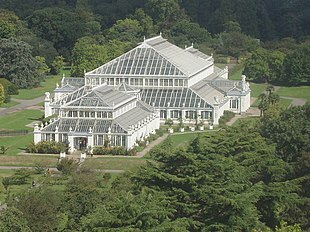
Back حدائق كيو Arabic Real Xardín Botánicu de Kew AST Kyu kral botanika bağları Azerbaijani Каралеўскія батанічныя сады К’ю Byelorussian Кралска ботаническа градина (Лондон) Bulgarian Reial Jardí Botànic de Kew Catalan Kew Royal Botanic Gardens CEB Královské botanické zahrady (Kew) Czech Gerddi Kew Welsh Kew Gardens Danish
| Kew Gardens | |
|---|---|
 A view across the gardens to the Palm House in Kew Gardens, in London, England | |
 | |
| Type | Botanical |
| Location | London Borough of Richmond upon Thames, England |
| Coordinates | 51°28′44″N 00°17′37″W / 51.47889°N 0.29361°W |
| Area | 121 hectares (300 acres) |
| Opened | 1759 |
| Visitors | more than 1.35 million per year |
| Species | > 50,000 |
| Public transit access | |
| Website | www |
| Official name | Royal Botanic Gardens, Kew |
| Criteria | Cultural: (ii), (iii), (iv) |
| Reference | 1084 |
| Inscription | 2003 (27th Session) |
| Area | 132 ha (330 acres) |
| Buffer zone | 350 ha (860 acres) |

Kew Gardens is a botanic garden in southwest London that houses the "largest and most diverse botanical and mycological collections in the world".[1] Founded in 1840, from the exotic garden at Kew Park, its living collections include some of the 27,000 taxa[2] curated by Royal Botanic Gardens, Kew, while the herbarium, one of the largest in the world, has over 8.5 million preserved plant and fungal specimens.[3] The library contains more than 750,000 volumes, and the illustrations collection contains more than 175,000 prints and drawings of plants. It is one of London's top tourist attractions and is a World Heritage Site.[4][5]
Kew Gardens, together with the botanic gardens at Wakehurst in Sussex, are managed by the Royal Botanic Gardens, Kew, an internationally important botanical research and education institution that employs over 1,100 staff and is a non-departmental public body sponsored by the Department for Environment, Food and Rural Affairs.[6]
The Kew site, which has been dated as formally starting in 1759,[7] although it can be traced back to the exotic garden at Kew Park, formed by Henry, Lord Capell of Tewkesbury, consists of 132 hectares (330 acres)[8] of gardens and botanical glasshouses, four Grade I listed buildings, and 36 Grade II listed structures, all set in an internationally significant landscape.[9] It is listed Grade I on the Register of Historic Parks and Gardens.[10]
Kew Gardens has its own police force, Kew Constabulary, which has been in operation since 1845.[11]
- ^ "Kew's scientific collections – Kew". www.kew.org. Retrieved 15 October 2017.
- ^ "Living collections at Kew". Kew.org.
- ^ "Science collections at Kew". kew.org.
- ^ Centre, UNESCO World Heritage. "Royal Botanic Gardens, Kew". UNESCO World Heritage Centre. Retrieved 24 April 2022.
- ^ "Most visited attractions in London UK 2021". Statista. Retrieved 24 April 2022.
- ^ Dyduch, Amy (28 March 2014). "Dozens of jobs at risk as Kew Gardens faces £5m shortfall". Richmond Guardian. Retrieved 26 June 2014.
- ^ "Royal Botanic Gardens, Kew". World Heritage. UNESCO. Retrieved 24 March 2009.
- ^ "Kew, History & Heritage" (PDF). Royal Botanic Gardens, Kew. Archived from the original (PDF) on 29 August 2008. Retrieved 24 January 2013.
- ^ "Director of Royal Botanic Gardens". Royal Botanic Gardens, Kew. 14 October 2010. Archived from the original on 15 March 2007. Retrieved 24 April 2012.
- ^ Historic England (1 October 1987). "Royal Botanic Gardens, Kew (1000830)". National Heritage List for England. Retrieved 13 November 2017.
- ^ "Quiz: Are you a Kew history buff?". Kew Gardens. Retrieved 3 October 2022.